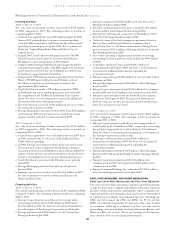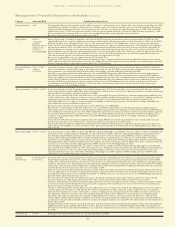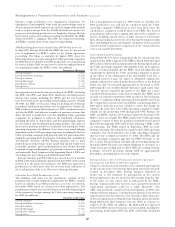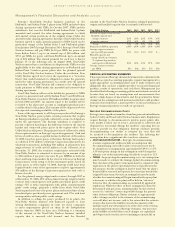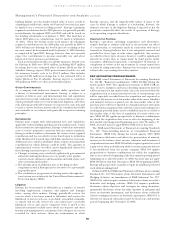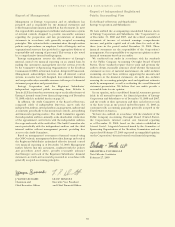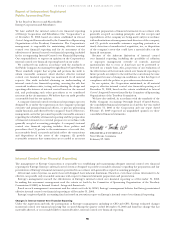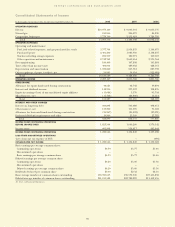Entergy 2008 Annual Report Download - page 48
Download and view the complete annual report
Please find page 48 of the 2008 Entergy annual report below. You can navigate through the pages in the report by either clicking on the pages listed below, or by using the keyword search tool below to find specific information within the annual report.
46
ENTERGY CORPORATION AND SUBSIDIARIES 2008
Management’s Financial Discussion and Analysis continued
46
Rough Production Cost Equalization Rates
2007 Rate Filing Based on Calendar Year 2006 Production Costs
In May 2007 Entergy filed with the FERC the rates to implement
the FERC’s orders in the System Agreement proceeding. The filing
shows the following payments/receipts among the Utility operating
companies for 2007, based on calendar year 2006 production costs,
commencing for service in June 2007, are necessary to achieve
rough production cost equalization as defined by the FERC’s
orders (in millions):
Payments or (Receipts)
Entergy Arkansas $ 252
Entergy Gulf States Louisiana
(includes ($30) million related to Entergy Texas) $(120)
Entergy Louisiana $ (91)
Entergy Mississippi $ (41)
Entergy New Orleans $ –
Entergy Texas $ (30)
Several parties intervened in the rate proceeding at the FERC,
including the APSC, the MPSC, the Council, and the LPSC, which
have also filed protests. The PUCT also intervened. Intervenor
testimony was filed in which the intervenors and also the FERC
Staff advocate a number of positions on issues that affect the level
of production costs the individual Utility operating companies are
permitted to reflect in the bandwidth calculation, including the
level of depreciation and decommissioning expense for nuclear
facilities. The effect of the various positions would be to reallocate
costs among the Utility operating companies. Additionally, the
APSC, while not taking a position on whether Entergy Arkansas was
imprudent for not exercising its right of first refusal to repurchase
a portion of the Independence plant in 1996 and 1997 as alleged
by the LPSC, alleges that if the FERC finds Entergy Arkansas to be
imprudent for not exercising this option, the FERC should disallow
recovery from customers by Entergy of approximately $43 million
of increased costs. The Utility operating companies filed rebuttal
testimony refuting the allegations of imprudence concerning the
decision not to acquire the portion of the Independence plant,
explaining why the bandwidth payments are properly recoverable
under the AmerenUE contract, and explaining why the positions of
FERC Staff and intervenors on the other issues should be rejected.
A hearing in this proceeding concluded in July 2008, and the ALJ
issued an initial decision in September 2008. The ALJ’s initial
decision concludes, among other things, that: (1) the decisions to
not exercise Entergy Arkansas’ option to purchase the Independence
plant in 1996 and 1997 were prudent; (2) Entergy Arkansas properly
flowed a portion of the bandwidth payments through to AmerenUE
in accordance with the wholesale power contract; and (3) the level
of nuclear depreciation and decommissioning expense reflected
in the bandwidth calculation should be calculated based on NRC-
authorized license life, rather than the nuclear depreciation and
decommissioning expense authorized by the retail regulators for
purposes of retail ratemaking. Following briefing by the parties, the
matter was submitted to the FERC for decision.
The Utility operating companies also filed with the FERC
during 2007 certain proposed modifications to the rough
production cost equalization calculation. The FERC rejected
certain of the proposed modifications, accepted certain of the
proposed modifications without further proceedings, and set
two of the proposed modifications for hearing and settlement
procedures. With respect to the proceeding involving changes to
the functionalization of costs to the production function, a hearing
was held in March 2008 and the ALJ issued an Initial Decision in June
2008 finding the modifications proposed by the Utility operating
companies to be just and reasonable. The matter is now pending
before the FERC for decision. In the second proceeding, a contested
settlement supported by the Utility operating companies is now
pending before the FERC. In conjunction with the second proceeding,
the LPSC has appealed to the Court of Appeals for the D.C. Circuit the
FERC’s determination that changes proposed by the Utility operating
companies and accepted by the FERC can become effective for the
next bandwidth calculation even though such bandwidth calculation
may include production costs incurred prior to the date the change is
proposed by the Utility operating companies. In August 2008, the D.C.
Circuit dismissed the LPSC’s appeal.
The intervenor AmerenUE has argued that its current
wholesale power contract with Entergy Arkansas, pursuant to
which Entergy Arkansas sells power to AmerenUE, does not
permit Entergy Arkansas to flow through to AmerenUE any portion
o f E n t e r g y A r k a n s a s ’ b a n d w i d t h p a y m e n t . A c c o r d i n g t o A m e r e n U E ,
Entergy Arkansas has sought to collect from AmerenUE
approximately $14.5 million of the 2007 Entergy Arkansas
bandwidth payment. The AmerenUE contract is scheduled to
expire in August 2009. In April 2008, AmerenUE filed a complaint
with the FERC seeking refunds of this amount, plus interest, in the
event the FERC ultimately determines that bandwidth payments
are not properly recovered under the AmerenUE contract.
On March 31, 2008, the LPSC filed a complaint with the FERC
seeking, among other things, three amendments to the rough
production cost equalization bandwidth formula. On April 22, 2008,
the Utility operating companies filed an answer to the LPSC complaint
urging the FERC to reject two of the proposed amendments and not
opposing the third. On July 2, 2008, the FERC issued an order that,
among other things, ordered the Utility operating companies to
implement the LPSC’s proposed amendment that they did not oppose
and setting two of the LPSC’s proposed amendments for hearing and
settlement proceedings. Settlement procedures have been terminated,
and a hearing is set for March 2009.
Entergy Arkansas paid $36 million per month to Entergy Gulf
States, Entergy Louisiana, and Entergy Mississippi for seven months,
beginning in June 2007. Management believes that any changes in
the allocation of production costs resulting from the FERC’s decision
and related retail proceedings should result in similar rate changes
for retail customers. The APSC has approved a production cost
allocation rider for recovery from customers of the retail portion of
the costs allocated to Entergy Arkansas, but set a termination date
of December 31, 2008 for the rider. In December 2007, the APSC
issued a subsequent order stating the production cost allocation
rider will remain in effect, and any future termination of the rider
will be subject to eighteen months advance notice by the APSC,
which would occur following notice and hearing. See “Fuel and
Purchased Power Cost Recovery, Entergy Texas,” in Note 2 to the
financial statements for discussion of a PUCT decision that Entergy
Texas is currently challenging regarding the rough production cost
equalization payments that could result in $18.6 million of trapped
costs between Entergy’s Texas and Louisiana jurisdictions.
Based on the FERC’s April 27, 2007 order on rehearing that
is discussed above, in the second quarter 2007 Entergy Arkansas
recorded accounts payable and Entergy Gulf States Louisiana,
Entergy Louisiana, Entergy Mississippi, and Entergy Texas
recorded accounts receivable to reflect the rough production
cost equalization payments and receipts required to implement
the FERC’s remedy based on calendar year 2006 production costs.
Entergy Arkansas recorded a corresponding regulatory asset for
its right to collect the payments from its customers, and Entergy
Gulf States Louisiana, Entergy Louisiana, Entergy Mississippi,
and Entergy Texas recorded corresponding regulatory liabilities
for their obligations to pass the receipts on to their customers.
The regulatory asset and liabilities are shown as “System Agreement
Cost Equalization” on the respective balance sheets.
In April 2007, the LPSC filed a complaint with the FERC in which
it sought to have the FERC order the following modifications to









